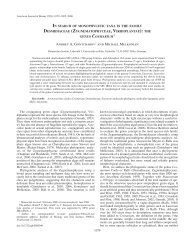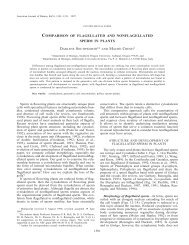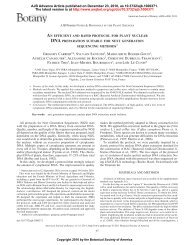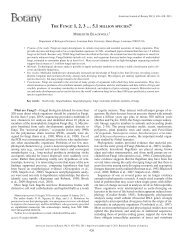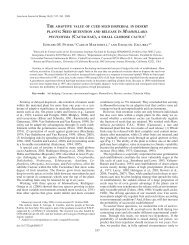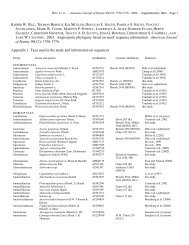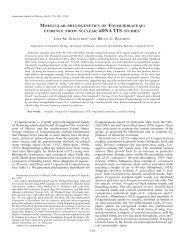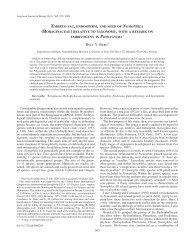View - American Journal of Botany
View - American Journal of Botany
View - American Journal of Botany
You also want an ePaper? Increase the reach of your titles
YUMPU automatically turns print PDFs into web optimized ePapers that Google loves.
1294 AMERICAN JOURNAL OF BOTANY<br />
[Vol. 86<br />
TABLE 3. Character values for species used in morphology-based cladistic analysis. V condition variable; ? condition unknown or not<br />
applicable.<br />
Species<br />
Character<br />
1 2 3 4 5 6<br />
123456789012345678901234567890123456789012345678901234567890<br />
Enkianthus campanulatus 000000000000000000000000000000000000000000000000000000000000<br />
Prionotes cerinthoides 0100000001011100000000020000000?000211?0000010000001000000?0<br />
Sprengelia incarnata 0100010101001101?0?200020000000?101211?000001000000100001010<br />
Agarista populifolia 1201001V010010000000V10101000000100011?00101100000010000101?<br />
Agarista salicifolia 10010011010010100000110101000000100011?0010110000001000010??<br />
Pieris floribunda 1000001001000000001011110110100100001010010110000001000010?1<br />
Pieris formosa 100000000100100000101111011010010000101001011000000100001011<br />
Pieris phillyreifolia 1000000001001000001011110110100110021010010110000001000000?1<br />
Pieris nana 11001001010010000010111101100001000110100V0110000001000010?1<br />
Craibiodendron yunnanense 11000001011110000010010101000000100111?0010110000001001010??<br />
Lyonia ferruginea 1100000101101000011011010100001010011V2001111010010101001011<br />
Lyonia lucida 110000010110100000101101011000101001102001111010010100001011<br />
Lyonia ligustrina 101000000010V00010101101011000101000102001111010010100001011<br />
Lyonia ovalifolia 111000010V10V000101011010110001010001020011110V0010100001011<br />
Vaccinium macrocarpon 01000001010000000001?00101000000000011?010011100102100000010<br />
Vaccinium meridionale 01000000010000100001110101000000000101010011101102100000010<br />
Satyria warszewiczii 01000001011000000001110101000000010011?01001110010210000V0?0<br />
Leucothoë fontanesiana 020000000100000000011111010000000001100001011000000110000001<br />
Leucothoë racemosa 010000000000000000011111010000000002100001011000000100000001<br />
Andromeda polifolia 0001000101001001?0?011010100010100001000000011000000100010011<br />
Zenobia pulverulenta 100000000000000000001101010000000001100101011000000100000001<br />
Chamaedaphne calyculata 0100001001000000020V11010100000V0002100010011000000100000001<br />
Diplycosia acuminata 01000000010100100001V10111010000V00211?01001100000010000112?<br />
Gaultheria miqueliana 000000000100000000011101010100000001100101011000000100000101<br />
Gaultheria shallon 0000010000100000000011101010101100000100101011000000100000001<br />
Pernettya tasmanica 00000000010000100001?102010101000000100100011000101100000001<br />
Tepuia cardonae 01000001110000100001100111000V0?000011?0100110001011000001??<br />
Oxydendrum arboreum 0200000V000000000001100100000000000011?001011000000100001011<br />
Note: 25: Enkianthus scored as ‘‘0’’ because it has free bracts, which are homologous to bracteoles. 28: the coding <strong>of</strong> this character for members<br />
<strong>of</strong> the Vaccinieae, e.g., Vaccinium and Satyria, is problematic; they are coded as ‘‘0’’ based on the assumption that the colorful, fleshy sepals in<br />
Gaultheria and Diplycosia developed independently from the fleshy fruits <strong>of</strong> Vaccinieae; developmental studies would be useful. 60: See also<br />
Hegnauer (1966) and Anderberg (1993).<br />
hairs (no. 47), and capsule with thickened sutures (no.<br />
50). Paired appendages on the filament (no. 39-2) are an<br />
additional synapomorphy under DELTRAN optimization.<br />
Agarista is supported by the apomorphies <strong>of</strong> leaves revolute<br />
in the bud (no. 4), leaves with a dense vein reticulum<br />
(no. 7), and stamens lacking appendages (no. 38).<br />
Gaultheria is monophyletic if Pernettya (as represented<br />
by P. tasmanica) is included, based on their fleshy calyx<br />
lobes (no. 28).<br />
The Lyonia group is monophyletic in some trees, but<br />
is paraphyletic in others because Andromeda polifolia is<br />
placed within the group (as sister to Agarista). Characters<br />
supportive <strong>of</strong> the monophyly <strong>of</strong> the Lyonia group include<br />
bands <strong>of</strong> fibers in the phloem (no. 1), S-shaped filaments<br />
(no. 33), disintegration tissue on back <strong>of</strong> anthers (no. 42),<br />
and more or less elongated testa cells (no. 57). Members<br />
<strong>of</strong> this group also have leaves with lignified epidermal<br />
cells (no. 13) and anomocytic stomata (no. 20-0). Both<br />
features also occur in Andromeda and in some trees function<br />
as synapomorphies. Generic relationships within the<br />
Lyonia group are poorly resolved, but Craibiodendron is<br />
always sister to Lyonia (Figs. 1, 2), a relationship consistently<br />
supported by their homogeneous pith (no. 2-1)<br />
and bifacial leaf midrib bundles (no. 11).<br />
The Gaultheria group is never monophyletic, although<br />
some <strong>of</strong> these genera, i.e., Gaultheria, Pernettya, Zenobia,<br />
Leucothoë, and also Chamaedaphne, are linked in a<br />
few cladograms by the base chromosome number <strong>of</strong> 11<br />
(no. 59). Gaultheria, Pernettya, and Zenobia <strong>of</strong>ten form<br />
a clade based on the presence <strong>of</strong> forked anther appendages<br />
(no. 40). The monophyly <strong>of</strong> Leucothoë is equivocal,<br />
but L. racemosa and L. fontanesiana are sometimes<br />
linked by their inflorescences that are exposed during the<br />
winter (no. 23), a feature that also evolved in Pieris (Fig.<br />
2).<br />
Finally, although not a major focus in this investigation,<br />
we note that Sprengelia incarnata and Prionotes<br />
cerinthoides form a clade in all trees that is supported by<br />
the lignified leaf epidermis (character no. 13), elongated<br />
epidermal cells (no. 14), pedicel with several bracteoles<br />
(no. 24-2), and smooth staminal filaments (no. 36-2).<br />
These two species represent the epacrid clade (see Crayn<br />
et al., 1996; Powell et al., 1996; Kron, 1997; Kron et al.,<br />
1998).<br />
Molecular data—Analysis <strong>of</strong> the rbcL data resulted in<br />
42 trees (L 503, CI 0.58, RI 0.50). The strict<br />
consensus (Fig. 3) indicates that few clades are well supported<br />
including: Vaccinieae (parjack 94), Lyonia (parjack<br />
99), and the Pieris floribunda P. formosa clade<br />
(parjack 90). Most <strong>of</strong> the structure in this tree collapses<br />
in trees one step longer. By contrast, the result <strong>of</strong> the<br />
matK analysis is much better resolved, especially within<br />
the Lyonia group (Fig. 4). In the matK analysis (four trees<br />
obtained, L 980, CI 0.65, RI 0.62) Vaccinieae<br />
and members <strong>of</strong> the Gaultheria group form a clade



